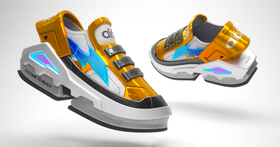Social Media Ads Cost Breakdown: Facebook, Instagram, TikTok, Pinterest and More
Get a full comparison of how much it costs to advertise on popular social media platforms including Facebook, Instagram, TikTok, Pinterest, and more.
Read More
Before Facebook rebranded itself to Meta in October 2021, the metaverse was a concept few beyond sci-fi and tech fans were familiar with.
Fast forward to 2022, and that has all changed. As the word “metaverse” enters cultural conversations, it may become difficult to wrap your head around exactly what it means.
What does the metaverse entail? How close are we to building the metaverse? And even more important for us marketers, should brands chart the virtual unknown or is it a waste of time and resources?
You’ve come to the right place: We’re here to demystify the metaverse, one question at a time.
The concept of a metaverse has deep roots in science fiction, specifically in the 1992 novel Snow Crash, where author Neal Stephenson depicted a society in which humans used avatar representations to interact with one another in a three-dimensional virtual space.
Since then, sci-fi authors have put their own spin on the metaverse — from Ernest Cline’s Ready Player One to Neuromancer by William Gibson.

Meta’s proposed metaverse isn’t quite as flashy as those depicted in sci-fi — yet.
When we describe the metaverse now, we typically refer to a virtual world people can access via a device, such as an augmented reality headset.
However, when it comes to what this virtual world looks like, the possibilities are endless: You could build a virtual home, go to school, visit a museum, host a meeting, and travel and sightsee, among other activities.
Free of physical boundaries, your avatar (which might be a human, animal, or even something abstract) can seamlessly interact with anyone in the world.

The Travis Scott Fortnite concert was one of the most unique virtual events to date.
Given the loose definition of the metaverse, one could argue we’ve already successfully built virtual worlds:
Second Life, the virtual multimedia world popular in the early 2000s, was a platform where your avatar could socialize, visit locations, launch a business, and buy virtual real estate. If you weren’t familiar with Second Life back then, trust us when we say it was huge: IBM used Second Life to hold business meetings, BBC debuted a TV show on the platform, and BMW created a digital showroom to help you buy virtual cars.
Tamagotchis, the handheld digital pet where users could connect their toys with other players and form friendships, share gifts, play games, and even get married.
Fortnite isn’t just a game for Gen Zs — it’s also the closest platform we have to a metaverse right now, according to its parent company, Epic Games. You can purchase virtual exclusive Nike Jordans (with real money), attend a Travis Scott live concert alongside millions of other users, or watch a Christopher Nolan film screening.
Horizon Worlds and Horizon Venues are early iterations of Meta’s proposed metaverse, which the company released in December 2021. The former is an expansive virtual reality social platform, while the latter focuses on virtual events. You can access both using the company’s Oculus virtual reality headset.
If you regularly consume marketing-related content, you’ve probably scrolled through dozens of think pieces discussing the metaverse. CNBC went so far as to declare the metaverse won Christmas, when Oculus saw a massive jump in downloads from the Apple app store in December 2021.
However, read past the headlines, and you’ll realize getting started with the metaverse is not as easy as it sounds. There is no fully built, widely adopted metaverse to invest in, and it’s unlikely there will be one for years to come. In other words, the infrastructure just isn’t there yet.
And though Fortnite has created jaw-dropping immersive experiences that have attracted millions of participants, the process isn’t cheap — in 2018, the platform asked for $25 million from potential sponsors for its now-annual esports tournament. (That’s five times the price of a Super Bowl ad.)
When the metaverse comes to life, it’s also unlikely to replace your current marketing strategy. Instead, expect it to be another media channel that resembles current out-of-home advertising — except in a virtual world. This means digital billboards, sponsorships, and even ads on a virtual TV or movie screen. That said, marketing in the metaverse probably won’t look significantly different from how you approach it now.
You may have heard Nike acquired RTKFT, a metaverse company, in December 2021. But that descriptor is a little vague — RTKFT is a tech company that builds collectibles, virtual products, and experiences for games and NFTs.
With more people buying virtual clothes for their in-game avatars, it’s a strategic acquisition that makes sense for both sides.

RTKFT is more of a virtual fashion brand than a metaverse company.
In short, it depends. Even with the affordability and accessibility of headsets like the Oculus, we’ve seen limited widespread adoption of virtual reality. These technologies have struggled to gain traction with consumers beyond gaming and virtual art exhibitions — and it’s unclear whether branding it as the metaverse will persuade the public to spend their days immersed in a virtual world rather than the real one.

How close are we to building a full-fledged metaverse? If you have an Oculus headset, download Horizon Worlds to see for yourself.
It’s also likely the metaverse — no matter its shape or form — will suffer from the same issues currently plaguing popular platforms: data harvesting, privacy, harassment, and trolling. Meta, for example, recently added a personal boundary tool to help combat sexual harassment in its Horizon Worlds and Horizon Venues apps.
We’re going to be honest: Brands have bigger hurdles to worry about than the metaverse, simply because there is no metaverse… yet. If the metaverse, complete with a significantly large, active user base, does transform how we approach marketing, it won’t be in 2022.
This doesn’t mean you should sit back and relax either. We’re starting to see people’s appetites for more immersive brand experiences grow — and with 5G technology powering more data-intensive digital activities, it’s only a matter of time before they become the norm.
If you have the budget and resources, why not spend time experimenting with new technologies and building virtual brand activations? From Snapchat’s virtual reality ecommerce tools to augmented reality for furniture apps, these features can help generate higher ROI and increase brand affinity.
The best part? There are numerous platforms that can transform your 2D product photos into an interactive 3D one — with no 3D model developers needed.
Want more ideas on how to get started with augmented and virtual reality for ecommerce? We’ve got you covered with this guide.
Last updated on May 10th, 2023.